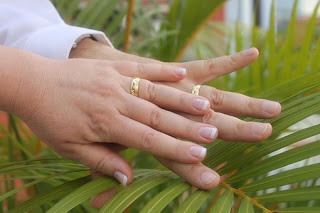Never forget to use base coat.
Painting your nails at home is no excuse to cut corners by skipping the base coat. Dr. Prystowsky points out that this step not only protects the nail from being stained by the polish, but also helps the color look more saturated and opaque with just one coat. And if you really want to take things to the next level, Dr. Shamban suggests adding a coat of clear gloss between each layer to add extra shine and protection.Read the labels.
Just as with makeup and skincare, not all nail polish brands are created equal, so make sure you're buying or using a good product. Dr. Debbie Palmer urges you to steer clear of polishes containing toxic chemicals like dibutyl phthalate, formaldehyde, and toluene, as these toxins can contribute to brittleness, splitting, and cracking.Seal the deal with a top coat.
Don't think you're squirming your way out of using top coat, either. This step is just as important, as the top coat seals in the polish's color and adds a much-needed gloss finish to your digits. Dr. Prystowsky recommends adding another top coat layer every three days to decrease chipping, so you'll get the most out of your manicure. Seriously, what's the point of spending all that time painting your nails if it only lasts a day?Indulge in acrylic or gel treatments sparingly.
Any nail expert you talk to is going to do their best to steer you away from acrylic or gel manicures — as long-lasting and convenient as they are because they're very hard on the nail. But if you're dead set on getting them, there are some ways to minimize the damage to your hands and nails. The main issue with a gel manicure is the exposure to UV light in the drying device, which can damage the skin below and around the nail, leading to an increased risk of cancer. To help reduce that risk, Dr. Prystowky recommends applying a sunscreen with an SPF of 30 to 50 before the procedure to help block the damage. Or you can try special gloves that expose only the nails themselves, shielding the rest of your hands from the harmful UV rays.Gives your nails a break.
Save the elaborate nail art and those bold colors with lots of pigment for the weekend, and during the rest of the week, give your nails time to rest and repair with a clear gloss. Dr. Shamban warns that going from one strong polish colour to another without giving your nails a break can dry them out, turn them yellow, and over time, even weaken the structure of the nail.Always moisturize.
You wouldn't go to sleep without moisturizing your face, so why should your nails be any different? Nail artist and expert Holly Falcone likes to use a mix of almond and avocado oils to keep cuticles and nails hydrated while she gets some shut-eye, but any nutrient-rich oil or moisturizer will do. In a pinch, you can even use a dab of lip balm.Use protection.
Gloves, ladies, gloves — get your mind out of the gutter! Whenever you're cleaning with harsh chemicals, gardening, or doing anything that involves soaking or dirtying your hands, Dr. Prystowsky insists that wear rubber, vinyl, nitrile or plastic gloves, preferably with a cotton liner. Cleaning dishes in hot, soapy water sans gloves can weaken the nails, while getting them caked with dirt from gardening will require a level of cleaning that you want to avoid wherever possible. Similarly, now that the weather is getting chilly, remember to wear a pair of mittens or gloves so that the cold air and wind don't undo the hard work you did moisturizing, leaving you with dry, flaky, scaly skin.Consider your diet.
Your fingernails are made of a protein called keratin, so just as with the clarity of your skin or the shine of your hair, you can improve your nails by tweaking your diet. Falcone advises adding vitamins and supplements like biotin, Vitamin E, and fish oil to your daily regimen, while Dr. Palmer recommends protein-rich foods like beans, fish, and nuts. The one thing every expert agrees on: Once you hit on the combination that works for you, you'll be rewarded with stronger, clearer nails.Source











No comments:
Post a Comment